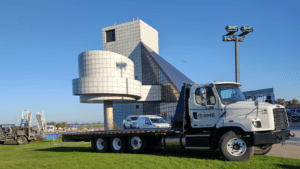
A Reliable Foundation for the Rock and Roll Hall of Fame Expansion
SME | Published on November 6, 2024

The Rock & Roll Hall of Fame is a unique fusion of artistic accomplishments: it’s dedicated to honoring a musical tradition whose roots stretch from pioneering musicians in the early 20th century to contemporary inductees like Cher, A Tribe Called Quest, and Elton John. The building itself is an architectural wonder designed by the renowned architect I.M. Pei, who designed the Rock Hall’s glass pyramid and auditorium to look like a turntable from an aerial view and create a vibrant, exciting visitor experience within.
Situated on Cleveland’s lakeshore, the Rock Hall has enriched the Cleveland area and music culture at large since 1995 by hosting events, educating students, inducting new members, and drawing a wide audience through diverse displays of rock subgenres. It’s an economic powerhouse for northeast Ohio, drawing around 600,000 visitors and generating an estimated $250 million of commerce annually. It also hosts tens of thousands of visiting K-12 students each year, fostering moments of creative expression in the next generation.
The Rock Hall is a defining presence on Cleveland’s Lake Erie lakefront, a feature the city is keen on developing as a world-class attraction where nature and culture meet. As a museum and music venue, the Rock Hall has served its community through student education, resident-only deals, and fostering a community-wide appreciation for music.
Today, the Rock Hall has a vision for building upon its impressive legacy through a 50,000 square-foot, $135 million triangle-shaped expansion. This initiative is epic in scope, adding a public-access atrium, student education rooms, an archive center, a lakefront community park, offices, exhibition rooms, and a 6,000 square-foot event space.
Before construction on the expansion began in 2021, the Rock Hall’s project partners recognized that putting a structure of this magnitude on the lakeside site’s weak soil and deep rock presented problems for supporting an expansion. This led structural engineers from LERA and contractors from A.M. Higley to request SME’s expertise for planning the foundation work.
Our geotechnical engineering team drilled 130 feet through soft lacustrine deposits of clay and silt down to the shale bedrock. These soft soils couldn’t support the foundation loads for the new addition, ruling out shallow foundations and leading the team to focus on deep foundation options. SME evaluated driven piles, drilled shafts, and augercast piles as possible foundation types. Working closely with the design team, we determined that augercast piles were the most cost-effective option.
Seismic site classification was also crucial for the foundation. The standard penetration resistance test resulted in classification E. This low grade suggested soil that was extremely susceptible to vibrations and earthquakes. However, SME performed shear wave velocity testing – a more sophisticated, informative test – to show the seismic site was classification D. Construction for this seismic class was better suited for the soil and provided significant savings to the Rock Hall.
The project also raised the possibility of methane releases. SME relied on expertise from our environmental team during foundation construction to guard against complications of both short- and long-term gas releases.
Vibration monitoring was similarly top-of-mind for our project managers. Our geotechnical team monitored construction vibrations to confirm the activity wouldn’t damage existing structures, such as the Rock Hall’s glass pyramid, the lakefront bulkhead, and the neighboring Great Lakes Science Center. Our construction materials services group was brought on to oversee the correct foundation installation process, given these complicating factors.
As of today, the foundation is in place and the project is headed skyward with slab and frame construction. SME remains involved throughout construction, providing steel, coatings, and nondestructive testing to verify connections and welds as the building goes up. The project is expected to be completed in 2026.
Our best work happens when teams collaborate through our One|SME culture. Through the Rock Hall expansion and similar projects, we take another step toward building and revitalizing our world. You can join our group of passionate people by viewing our open positions.





